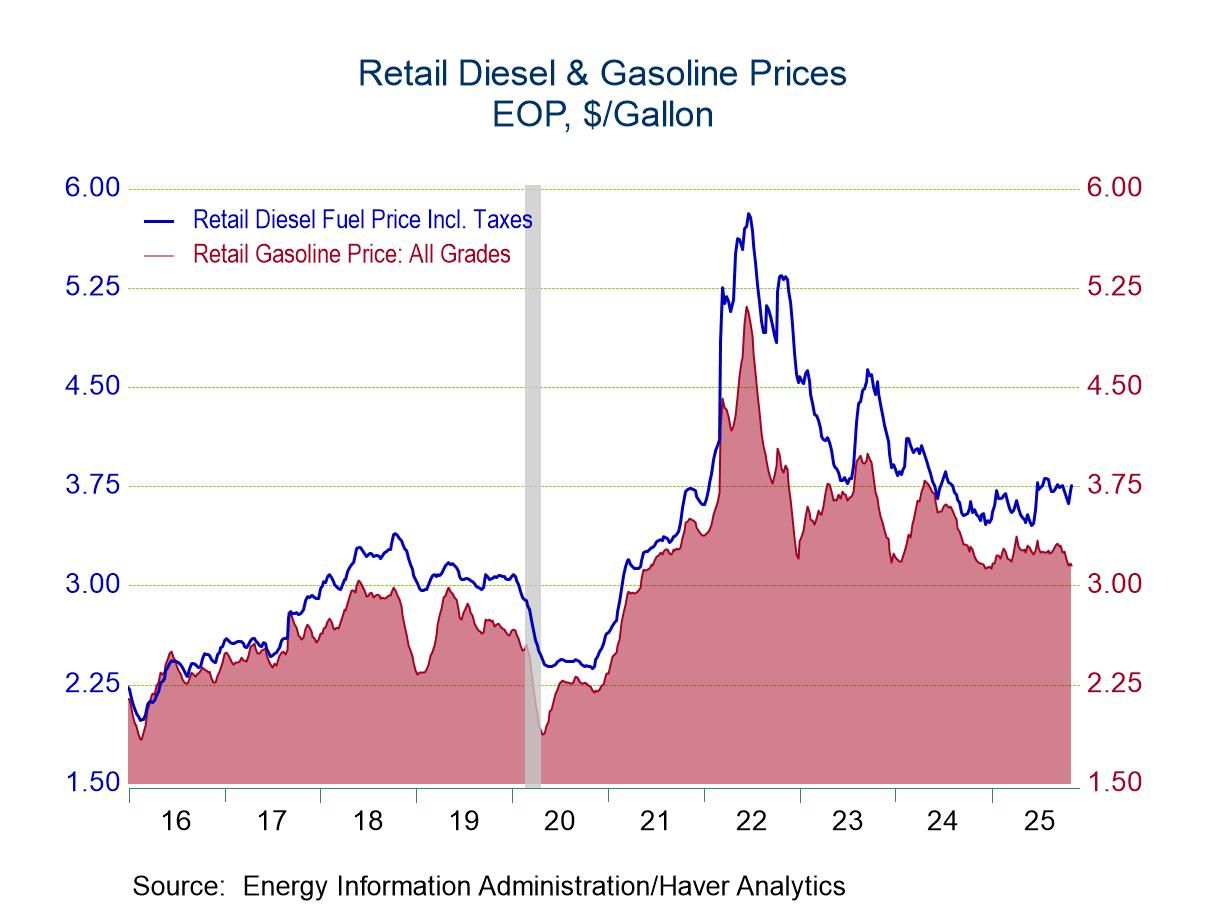 Global| Sep 10 2008
Global| Sep 10 2008JOLTS: U.S. Job Openings Fell in July
by:Tom Moeller
|in:Economy in Brief
Summary
The Bureau of Labor Statistics reported in the July Job Openings & Labor Turnover Survey (JOLTS) that the number of job openings fell a revised 2.3% (-17.0% y/y) from June. The drop followed a revised 3.7% June decline which was much [...]
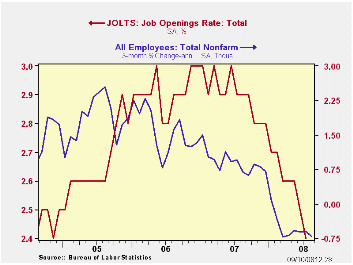
The Bureau of Labor Statistics reported in the July Job Openings & Labor Turnover Survey (JOLTS) that the number of job openings fell a revised 2.3% (-17.0% y/y) from June. The drop followed a revised 3.7% June decline which was much larger than reported initially. Since the peak in January of 2007, the number of job openings have fallen 21%.
The job openings rate fell to 2.4% from a downwardly revised 2.5% in June. The latest figures are down from near 3% one year ago. The job openings rate is the number of job openings on the last business day of the month as a percent of total employment plus job openings.
The actual number of job openings in the construction sector
fell 16.0% (-48.1% y/y) while the number of job openings in the manufacturing sector fell at
the same rate as in June, by 3.3% (-29.6% y/y). Professional &
business services job openings fell 10.4% (-12.4% y/y) while openings
in the education & health sectors slipped 1.2% (-2.6% y/y)
after an upwardly revised June increase of 5.2%. Openings in retail
trade also reversed the prior month's decline with a 16.1% increase
(-1.1% y/y).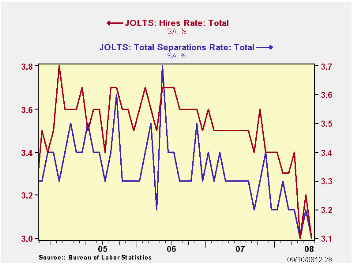
By region, openings in the Northeast fell by 3.3% (-19.8% y/y). They were down by 5.6% (-15.1% y/y) in the South and off 4.3% (-15.3% y/y) in the Midwest.In the West openings rose by 5.3% (-20.2% y/y).
The hires rate fell to 3.0% from an upwardly revised June rate of 3.2%. The latest matched the low for this cycle and it was the lowest since early-2003.The hires rate is the number of hires during the month divided by employment.The actual number of hires fell 8.5% (-15.7% y/y). Hires in the construction sector fell by one-quarter m/m and they were off by one-third from last July. In the factory sector hires fell 11.2% (-28.7% y/y) and in the professional & business services sector they fell by 11.4% (-10.4% y/y). In the leisure and hospitality sector hires rose 4.6% during July but they still were off 10.8% y/y.
The job separations rate fell to 3.1%, the lowest since 2003 and down from 3.7% at the peak. Separations include quits, layoffs, discharges, and other separations as well as retirements. The level of job separations fell 3.5% y/y.
The JOLTS survey dates only to December 2000 but has since followed the movement in nonfarm payrolls, though the actual correlation between the two series is low.
A description of the Jolts survey and the latest release from the U.S. Department of Labor is available here.
The Budget and Economic Outlook: An Update from the Congressional Budget Office can be found here
| JOLTS (Job Openings & Labor Turnover Survey) | July | June | July '07 | 2007 | 2006 | 2005 |
|---|---|---|---|---|---|---|
| Job Openings, Total | ||||||
| Rate (%) | 2.4 | 2.5 | 2.9 | 2.8 | 3.0 | 2.8 |
| Total (000s) | 3,416 | 3,497 | 4,116 | 3,974 | 4,272 | 3,863 |
| Hires, Total | ||||||
| Rate (%) | 3.0 | 3.2 | 3.5 | 41.9 | 43.4 | 43.1 |
| Total (000s) | 4,062 | 4,438 | 4,818 | 57,771 | 59,153 | 57,501 |
by Tom Moeller September 10, 2008
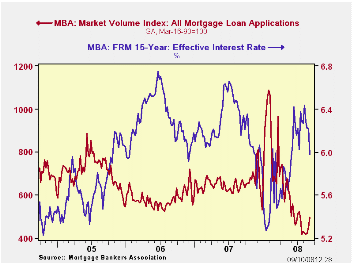
The total number of mortgage applications jumped 9.5% last week after a 7.5% increase during the week prior, according to the Mortgage Bankers Association. As a result, applications in early-September were 15.3% above the August average and the rise recovered an 11.5% decline during that month.
The latest figures include an adjustment to account for the Labor Day Holiday. On an unadjusted basis, the index decreased 13.6% compared with the previous week and was down 24.4% compared with the same Labor Day week one year earlier. In early September the level of all mortgage applications was down by one-quarter from the year-ago level.
Purchase applications rose by 6.4% after the prior week's 10.5% increase. Early this month applications rose 15.4% from August during which they declined 6.1%.
During the last ten years there has been a 61% correlation between the y/y change in purchase applications and the change in new plus existing single family home sales.
Applications to refinance a home mortgage jumped 15.4%.
Applications began this month 14.8% above the August average after that
month's 19.9% decline.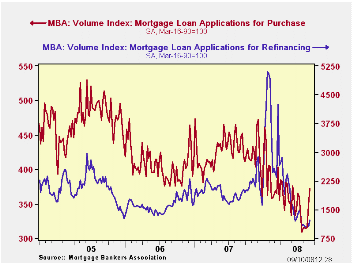
The effective interest rate on a conventional 15-year mortgage declined to 5.98% following an average of 6.29% last month. For a thirty year mortgage, rates fell to 6.26%. Interest rates on 15 and 30 year mortgages are closely correlated (>90%) with the rate on 10-year Treasury securities. For an adjustable rate 1-Year mortgage the rate fell to 7.08% from 7.22% averaged last month.
During the last ten years there has been a (negative) 79% correlation between the level of applications for purchase and the effective interest rate on a 30-year mortgage.
The Mortgage Bankers Association surveys between 20 to 35 of the top lenders in the U.S. housing industry to derive its refinance, purchase and market indexes. The weekly survey covers roughly 50% of all U.S. residential mortgage applications processed each week by mortgage banks, commercial banks and thrifts. Visit the Mortgage Bankers Association site here.
How Much Have House Prices Fallen? from the Federal Reserve Bank of St. Louis is available here.
| MBA Mortgage Applications (3/16/90=100) | 09/05/08 | 08/29/08 | Y/Y | 2007 | 2006 | 2005 |
|---|---|---|---|---|---|---|
| Total Market Index | 496.2 | 453.1 | -24.5% | 652.6 | 584.2 | 708.6 |
| Purchase | 371.5 | 349.0 | -17.1% | 424.9 | 406.9 | 470.9 |
| Refinancing | 1,222.9 | 1,059.7 | -34.8% | 1,997.9 | 1,634.0 | 2,092.3 |
by Robert Brusca September 10, 2008
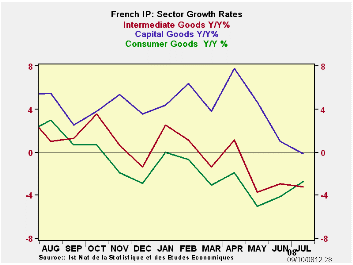
French IP made a surprise jump of 1.2% in July but only after a larger decline in June and in the wake of a plunge in May and so that the rise has not restored any momentum to the outlook. The sequential growth rates show a steady weakening in output across sectors with the overall output measure decelerating steadily from 12 months to 6 months to 3 months. The sector paths are a little more uneven than that with consumer goods output even showing an increase over three months. That sector also is posting a gain in the quarter-to-date calculations and it’s the only one to do so. That is largely because auto output is up in the quarter and was up very strongly in July (a 5.1% pace!).
On balance French measures of economic activity have held up well until just before mid-year. The EU has today downgraded the growth outlook for most European countries. It projects what are essentially recessions in Germany, Spain and the UK. However, Italy and France have escaped that list. But France is starting to feel the blow of weaker growth later than some of the others so the jury is still out on how weak France will be and how soon the weakness will manifest itself.
| French IP Excluding Construction | |||||||
|---|---|---|---|---|---|---|---|
| Saar except m/m | Jul-08 | Jun-08 | May-08 | 3-mo | 6-mo | 12-mo | Quarter-to-date |
| IP total | 1.2% | -0.6% | -3.0% | -9.5% | -3.8% | -2.0% | -1.5% |
| Consumer | 1.3% | 0.6% | -1.5% | 1.6% | -2.1% | -2.8% | 7.4% |
| Capital | 0.6% | -1.6% | -1.4% | -9.2% | 0.5% | -0.2% | -5.6% |
| Intermediate | 1.1% | -0.6% | -3.1% | -10.5% | -6.0% | -3.2% | -2.7% |
| Memo | |||||||
| Auto | 5.1% | -2.8% | -8.0% | -21.9% | -14.7% | -3.5% | 1.2% |
Tom Moeller
AuthorMore in Author Profile »Prior to joining Haver Analytics in 2000, Mr. Moeller worked as the Economist at Chancellor Capital Management from 1985 to 1999. There, he developed comprehensive economic forecasts and interpreted economic data for equity and fixed income portfolio managers. Also at Chancellor, Mr. Moeller worked as an equity analyst and was responsible for researching and rating companies in the economically sensitive automobile and housing industries for investment in Chancellor’s equity portfolio. Prior to joining Chancellor, Mr. Moeller was an Economist at Citibank from 1979 to 1984. He also analyzed pricing behavior in the metals industry for the Council on Wage and Price Stability in Washington, D.C. In 1999, Mr. Moeller received the award for most accurate forecast from the Forecasters' Club of New York. From 1990 to 1992 he was President of the New York Association for Business Economists. Mr. Moeller earned an M.B.A. in Finance from Fordham University, where he graduated in 1987. He holds a Bachelor of Arts in Economics from George Washington University.



